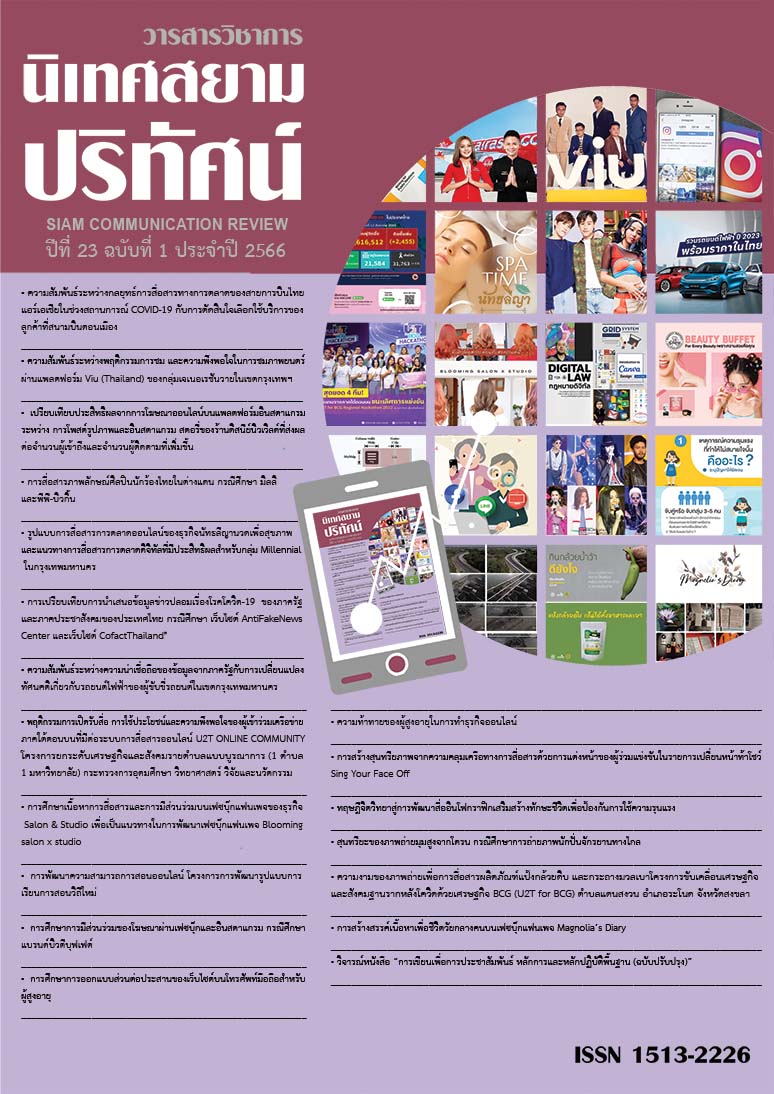Creating Aesthetic Communication from the Imprecision of Competitor Makeup in TV Show “Sing Your Face Off”
Main Article Content
Abstract
Article Details

This work is licensed under a Creative Commons Attribution-NonCommercial-NoDerivatives 4.0 International License.
References
กาญจนา แก้วเทพ. (2545). สื่อบันเทิง: อำนาจแห่งความไร้สาระ. กรุงเทพฯ: ออล อเบ้าท์ พริ้นท์.
________. (2553). แนวพินิจใหม่ในสื่อสารศึกษา. กรุงเทพฯ: คณะนิเทศศาสตร์ จุฬาลงกรณ์มหาวิทยาลัย.
เจริญพงศ์ ศรีสกุล. (2550). การออกแบบเนื้อหาส่วนควบและส่วนขยายในสื่อดีวีดีภาพยนตร์. วิทยานิพนธ์ปริญญานิเทศศาสตรมหาบัณฑิต, สาขาวิชาการสื่อสารมวลชน คณะนิเทศศาสตร์ จุฬาลงกรณ์มหาวิทยาลัย.
ชญาณ ลำเภา. (2556). การศึกษาทัศนคติ การรับรู้ และพฤติกรรมการบริโภค ตามกระแสเกาหลีนิยม. วิทยานิพนธ์ปริญญาวิทยาศาสตรมหาบัณฑิต (สถิติประยุกต์), คณะสถิติประยุกต์ สถาบันบัณฑิตพัฒนบริหารศาสตร์.
ไชยรัตน์ เจริญสินโอฬาร. (2554). แนะนำสกุลความคิดหลังโครงสร้างนิยม. กรุงเทพฯ: สมมติ.
พฤษธิ์ ศุภเศรษฐศิริ. (2543). การแต่งหน้าเพื่อการแสดง. กรุงเทพฯ: เศรษฐศิลปะ.
พัฒนา กิตติอาษา. (2546). มานุษวิทยากับการศึกษาปรากฏการณ์โหยหาอดีตในสังคมไทยร่วมสมัย. กรุงเทพฯ: ศูนย์มานุษยวิทยาสิรินธร.
รุ้งนภา ยรรยงเกษมสุข. (2555). “การโหยหาอดีต: ความเป็นอดีตในสังคมสมัยใหม่”. วารสารการเมืองการบริหาร และกฎหมาย, 4(2), 59-89.
ศิริชัย ศิริกายะ. (2558). แบบจำลองการสื่อสารในยุคดิจิทัล. วารสารนิเทศสยามปริทัศน์, 13(15), 8-13.
ศิริชัย ศิริกายะ. (2559). ทฤษฎีควอนตัมฟิสิกส์กับการควบรวมและการแปลงรูปองค์ประกอบการสื่อสารในยุคดิจิทัล. วารสารนิเทศสยามปริทัศน์, 15(19), 7-9.
สาธิดา เตชะภัทรพร. (2541). บทบาทของการแต่งหน้าในฐานะเป็นส่วนขยายความรู้สึกทางด้านจิตใจในสื่อวิทยุโทรทัศน์. วิทยานิพนธ์ปริญญานิเทศศาสตรมหาบัณฑิต, สาขาวิชาการสื่อสารมวลชน คณะนิเทศศาสตร์ จุฬาลงกรณ์มหาวิทยาลัย.
สุรพงษ์ ลือทองจักรม. (2552). หลักมานุษยวิทยาและหลักสังคมวิทยา. อุดรธานี: คณะมนุษยศาสตร์และสังคมศาสตร์.
สุรพงษ์ โสธนะเสถียร. (2563). ทฤษฎีการสื่อสาร. กรุงเทพฯ: ระเบียงทอง.
Berger, A. (1992). Popular Culture Genre: Theories and Texts. New York: Sage.
Boorstin, D. (1973). The Image: A Guide to Pseudo-Events in America. New York: Atheneum.
Burton, G. (2002). More Than Meets the Eyes: An Introduction to Media Studies. New York: Arnold.
Buszek, M. (2006). Pin-up grrrls: feminism, sexuality, popular culture. Durham: Duke University Press
Corson, R. (1986). Stage Makeup. New Jersey: Prentice Hall.
Dunn, R. (1991). Postmodernism: Populism, Mass Culture, and Avant-Garde. Theory Culture and Society, 8, 111-135.
Fiske, J. (1982). Introduction to Communication Studies. New York: Methuen & Co. Ltd.
Koester, A. W., & Bryant, N. O. (1991). Fashion terms and styles for women’s garments. Corvallis, OR: Oregon State University Extension Service.
Stuller. (2019). The Basics of Jewelry Terminology & Design Guide. LA: The Mineralogical Record.
Jericho, J. (2019). Footwear Fashion Design - Staking Your Signature Style. Retrieved from https://journalistethics.com
Jihan, F. (2021). It's Time for the 2000s Pouf Hairstyle to Make a Comeback. Retrieved from https://www.allure.com/story/2000s-hair-pouf-comeback.


